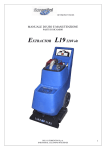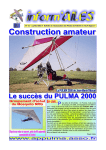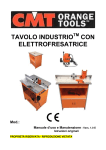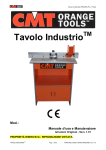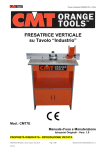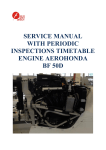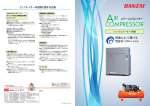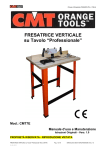Download Benassi MC 3300 Specifications
Transcript
REVERSIBLE TWO-WHEEL TRACTOR MC 3300 MC 4300 SERIES Operation and Maintenance Manual OPERATION AND MAINTENANCE MANUAL Contents General details _________________________________________________________________________________ 3 Introduction ____________________________________________________________________________________ 3 Information about the guarantee ____________________________________________________________________ 3 Training _______________________________________________________________________________________ 4 Key of symbols _________________________________________________________________________________ 4 Read immediately: ______________________________________________________________________________ 5 Operation _____________________________________________________________________________________ 5 Unsafe practice _________________________________________________________________________________ 5 Machine description _____________________________________________________________________________ 6 Specifications and performance ____________________________________________________________________ 6 Implements ____________________________________________________________________________________ 7 Remark on attaching implements _________________________________________________________________ 7 Description of controls____________________________________________________________________________ 8 Version of the machine with cutters _________________________________________________________________ 9 Adjusting the tilling depth _______________________________________________________________________ 9 Reverse of the machine_____________________________________________________________________ 10 Positions and controls of levers _______________________________________________________________ 11 Working procedure _____________________________________________________________________________ 11 Adjustements _____________________________________________________________________________ 12 Starting the machine _______________________________________________________________________ 14 Operating the machine __________________________________________________________________________ 15 General warnings while working ___________________________________________________________________ 15 Filling and emptying the fuel tank __________________________________________________________________ 15 Switching the machine off ________________________________________________________________________ 16 Storage of the machine __________________________________________________________________________ 16 Residual Risk _________________________________________________________________________________ 17 Maintenance __________________________________________________________________________________ 18 General guidelines ___________________________________________________________________________ 18 Engine ____________________________________________________________________________________ 18 Gear: checking the oil level ____________________________________________________________________ 18 Gear: changing the oil ________________________________________________________________________ 19 Greasing power takeoff _______________________________________________________________________ 19 Periodical operations _________________________________________________________________________ 19 Cleaning _____________________________________________________________________________________ 20 General guidelines ___________________________________________________________________________ 20 Disassembly __________________________________________________________________________________ 21 CE Mark _____________________________________________________________________________________ 21 Air noise and vibrations produced by the machine _____________________________________________________ 22 Index of pictures Picture 1 – General view __________________________________________________________________________ 6 Picture 2 – Attaching implements ___________________________________________________________________ 7 Picture 3 - Description of controls ___________________________________________________________________ 8 Picture 4 – Machine: version with cutters _____________________________________________________________ 9 Figura 5 – Adjusting the tilling depth _________________________________________________________________ 9 Picture 6 - Reverse of the machine _________________________________________________________________ 10 Picture 7 – Positions and controls of levers___________________________________________________________ 11 Picture 8 - Adjustment of the height of the handle______________________________________________________ 12 Picture 9 - Handle side adjustment _________________________________________________________________ 12 Picture 10 – Locking the differential ________________________________________________________________ 12 Picture 11 – Adjusting wheels with flange ____________________________________________________________ 13 Picture 12 - Taking off the wheels spacers ___________________________________________________________ 13 Picture 13 – Switching the engine off _______________________________________________________________ 16 Picture 14 – Gear oil level ________________________________________________________________________ 18 Picture 15 – Changing gear oil ____________________________________________________________________ 19 Picture 16 - Greasing takeoff______________________________________________________________________ 19 Picture 17 - Plate with CE Mark ________________________________________Errore. Il segnalibro non è definito. Index of tables Table 1 – Information and Training __________________________________________________________________ 4 Table 2 – Specifications and performance ____________________________________________________________ 6 Table 3 - Noiseness and vibrations _________________________________________________________________ 22 Page 2 of 22 OPERATION AND MAINTENANCE MANUAL General details Producing firm: BENASSI SpA Via Lampedusa, 1 Tel. 0039 051 820534 Fax 0039 051 6826164 e-mail: [email protected] www.benassispa.it This manual has been written by the Industrial Engineer Mr CIAVAGLIA Sergio Global Service Italia Srl - 63029 Servigliano (ITALIA) Introduction Dear Customer, this manual has been written thanks to the considerable experience we have acquired so far. Its purpose is to help you in operating the machine properly during all the phases of its life. The manual should be kept with the machine, in a safe place, accessible to all those who need to consult it. Those who have not read, understood and learned the instructions of this manual must not operate the machine. Should the manual be lost or spoiled, please ask your retailer for a copy, giving him all the relevant information about the machine The manual and the declaration of conformity should always be kept with the machine, both when it is sold and when it is hired, and until the hire ceases. Information about the guarantee We remind you that, before using this REVERSIBLE TWO-WHEEL TRACTOR, all those who will drive it must be informed about the conditions of use and cautioned against unsafe practice. This manual contains all such information, and through it you can obtain the best performance of the machine. We have actually found that many of the troubles that have been reported should be mainly ascribed to the operator’s inattention or to wrong maintenance and/or adjustments. As a consequence, we cannot accept claims for compensation for damage caused by wrong handlings or for loss of liabilities due to the impossibility to work when the machine is broken. All the electrical and mechanical parts that undergo normal wear and tear are not covered by guarantee. DURATION OF THE GUARANTEE The guarantee has a maximum duration of 24 months. For mechanical parts, the guarantee only covers spare parts; it does not cover the labour nor the travelling expenses connected to assembly. If any faulty parts have to be repaired, they should be sent to us carriage paid. We will repair and ship them carriage forward. When ordering spare parts, always give the following details: Model Number Year of production Model Number The instructions, the pictures and the information contained in this manual are a technical and reserved property of the producing firm and cannot be reproduced with any means, neither in whole nor in part. Page 3 of 22 OPERATION AND MAINTENANCE MANUAL Training If this REVERSIBLE TWO-WHEEL TRACTOR is used in a firm, we remind you that, before using it, all those who will drive it must be informed about the conditions of use and cautioned against unsafe practice. This manual contains all such information, and through it you can obtain the best performance of the machine. For a non-professional use, the retailer must train the user. Any Information and Training should be written down in this table. Topic Trainer Worker Date Table 1 – Information and Training Key of symbols To allow you better understand this manual, we will explain here some terms and symbols: Remark to be read carefully QUALIFIED TECHNICIAN OPERATOR Person who has the task to set up, operate, adjust, deal with normal maintenance of and clean the machine. Person trained and qualified to solve problems with adjustment and operation of the machine, and to manage extraordinary maintenance or to repair the machine when a particular knowledge of the machine, of its functioning, of safety regulations and of technical procedures is required. Please read the manual before doing anything Presence of a danger Something you should never do Something you should always do THE COLOURS OF THE REMARKS HAVE THE FOLLOWING MEANINGS: BLUE RED ORANGE ALWAYS NEVER DANGER Benassi Spa, as the firm producing the REVERSIBLE TWO-WHEEL TRACTOR, disclaims any responsibility for any damage that can be ascribed to an improper use, to inattention or to the breach of safety regulations. It also disclaims any responsibility for any damage that may occur during the transport, unpacking and handling of the machine. Page 4 of 22 OPERATION AND MAINTENANCE MANUAL Read immediately: WARNING BEFORE: ⇒ HANDLING THE MACHINE; ⇒ USING THE MACHINE; ⇒ ADJUSTING; ⇒ CLEANING; ⇒ OPERATIONS OF MAINTENANCE READ THE OPERATION MANUALS (MACHINE AND ENGINE) IF THE REVERSIBLE TWO-WHEEL TRACTOR IS USED IN A FIRM, WE REMIND YOU TO HAND IN A COPY OF THE MANUALS TO THE MAINTENANCE MANAGER. THE MAINTENANCE MANAGER MUST HAND IN AN ABSTRACT OF THE MANUALS TO THE WORKER IN CHARGE OF THE MACHINE, SPECIFYING THE INFORMATION ABOUT HIS TASKS. Operation The REVERSIBLE TWO-WHEEL TRACTOR MC3300 – MC4300 SERIES, hereinafter called machine, is designed to be used in agriculture, farming and flower-growing. It is a self-propelled machine with a single axle. It can work in a variety of settings, according to the attachments used, such as: ⇒ Working the ground (using hoe-shaped cutters); ⇒ Mowing the grass (using a sickle bar); ⇒ Transporting small volumes (using a trailer); ⇒ Other uses (using ploughs, lawn mowers, snow throwers, etc.). The machine has an internal-combustion engine. Manuals provided by the producer explain how to change attachments. For the machine to run, a worker is needed to control it continuously. Unsafe practice FOR THE RETAILER: only qualified staff should deal with all the operations needed to set up the machine. Such procedures must follow the instructions contained in the SETTING UP MANUAL. Should the user make modifications to the machine, he is required to remove the CE mark. Everything that this manual does not treat explicitly is to be considered forbidden. The machine must not be used if there is danger of fire and/or explosion. It is forbidden to drive the machine on roads. Page 5 of 22 OPERATION AND MAINTENANCE MANUAL Machine description The two-wheel tractor is build on a metal frame where the other parts are fixed: the engine, the gear, the axle and the steering handle, as you can see from the picture: Hand throttle control Clutch and motor-stop controls Gear levers control Differential lock controls Bonnet Steering handle Engine Self-winding starter rope Attachment: cutters with protective case Wheels Picture 1 – General view Specifications and performance Operation Max mass (according to the model) Size Max forward/backward speed Max pressure pneumatic tyres (agricultural tread) Min steering diameter Engine specifications Daytime 90-120 kg See tecnhical tables See engine manual Table 2 – Specifications and performance TILLING VERSION MOWING VERSION Page 6 of 22 OPERATION AND MAINTENANCE MANUAL Implements The machine can be operated as well with the following implements: SICKLE BAR, PLOUGH, MOWER, SNOW THROWER, TRAILER, SHREDDER, REVERSIBLE PLOUGH, LEVELLING BLADE, ROTARY SWEEPER. For other implements, please get in touch with the producing firm. To attach and use the different implements, refer to the specific manual. Remark on attaching implements When attaching implements, you should follow the following instructions. operation to be performed while the machine is switched off and well stable; operation to be performed only by trained and informed staff; only use implements compatible with the machine and following the instruction provided by the producing firm; Rocker arm attach the implement properly, being careful that the centring rings join together put the safety plate of the implement under the rocker arm, on the internal side of the lever Plate Centring rings Point for attachment Tighten the screws with a proper spanner, gradually and alternating the screws. N.B.: The trailer must be attached in a particular place (shown in the picture above), different from the power takeoff Picture 2 – Attaching implements Danger of bruising and manual load handling If the implement is too heavy, you should perform the operations in two or using adequate means, and following the proper instructions Page 7 of 22 OPERATION AND MAINTENANCE MANUAL Description of controls Warning lights Ignition key (for those models who have it) Motor-stop lever Handle height adjustment lever Hand throttle control Clutch lever Button to lock clutch lever and motor-stop lever Button to lock differential lever Lever to lock differential Speed direction lever (reverser) Gear lever Lever to engage/disengage power takeoff Functions of warning lights Neutral position (0) ALTERNATOR ALTERNATOR OIL Picture 3 - Description of controls Page 8 of 22 OPERATION AND MAINTENANCE MANUAL Version of the machine with cutters In this version the machine has cutters to till the soil. The external parts of the cutters and of the protective case can be disassembled, so you can vary the width of the machine. The widths you can obtain are as follows. CUTTER WIDTH (mm) LARGHEZZA (mm) Protecti ve case VOLPINO Hoeshaped cutters 570 760 460 630 370 480 280 360 CASTORO Picture 4 – Machine: version with cutters To assemble the implements, consult the manuals provided by the producing firm. WHATEVER WIDTH YOU DESIRE, THE CUTTERS MUST BE SET SYMMETRICALLY WITH THE AXE OF THE MACHINE. DANGER OF OVERTURNING AND OF INSTABILITY: IF THE CUTTERS ARE NOT ASSEMBLED SYMMETRICALLY, THE MACHINE IS UNSTABLE, DANGEROUS AND CAN OVERTURN. Adjusting the tilling depth The hoe-shaped cutters have a device to adjust the depth of tilling of the soil. DANGR OF BRUISING AND CRUSHING OPERATIONS TO PERFORM WHEN THE MACHINE IS TURNED OFF AND STABLE WEAR PROPER GLOVES Tilling depth adjuster Figura 5 – Adjusting the tilling depth Page 9 of 22 OPERATION AND MAINTENANCE MANUAL Reverse of the machine In order to attach different implements, the machine can be reversed by turning the handle 180 degrees, as it is described in this page. OPERATION TO PERFORM WHEN THE MACHINE IS TURNED OFF During these operation: DANGER OF BRUISING AND CRUSHING Before reversing the handle, you need to take away the levers that control the speed direction and the power takeoff. 1 – Take the split pins from the levers 2 – Pull the levers out of their places 3 – Take the levers out of the loops FOR THE REVERSE, THE HANDLE SHOULD ONLY BE TURNED CLOCKWISE 4 – Raise completely the lever that locks the side adjustment of the steering handle 5 – Unlock the lever and with the other hand rotate the steering handle 6 – take the handle to the opposite side, above the engine 7 – lock the handle by lowering the lever TO GET IT TO ITS NORMAL POSITION, ONLY COUNTERCLOCKWISE 8 – put the levers back into the loops, then in their place and finally lock them with the split pins Picture 6 - Reverse of the machine WARNING!! In the reversed position the levers need to be inverted, so the controls as well are inverted. You should refer to the paragraph “Positions and controls of levers”. To perform maintenance of the engine in the reversed position, you need to turn the handle to one side, otherwise the bonnet of the engine cannot be opened. Page 10 of 22 OPERATION AND MAINTENANCE MANUAL Positions and controls of levers The position of motion lever and the effect obtained by using them depend on the configuration of the machine (normal or reversed). The pictures below show the two different situations. Power takeoff lever Power takeoff can be engaged only with forward speed. To engage takeoff, engage clutch and then push the lever towards the machine. To disengage it, pull the lever towards you. Speed direction lever To drive forward, engage clutch and then push lever towards the machine. To drive backwards, pull the lever towards you. Power takeoff lever To engage power takeoff lever, engage clutch and then pull the lever towards you. To disengage it, push the lever towards the machine. Speed direction lever To drive forward, engage clutch and then push lever towards the machine. To drive backwards, pull the lever towards you. Before driving backwards, power takeoff ought to be disengaged. Speed lever To engage gears, engage clutch and move the lever until it stops on the number of the speed you want, which is written on the gear. Speed lever To engage gears, engage clutch and move the lever until it stops on the number of the speed you want, which is written on the gear. th In reverse position, 4 speed cannot be used. Picture 7 – Positions and controls of levers Working procedure When working on sloped surfaces, you should drive the tractor parallel with the slope and not uphill nor downhill. Be very careful while changing direction. Page 11 of 22 OPERATION AND MAINTENANCE MANUAL Adjustements The machine can be adjusted in some ways, which are shown as follows. OPERATION TO PERFORM During these operations: WHEN THE MACHINE IS SWITCHED OFF DANGER OF BRUISING AND CRUSHING You can adjust the height of the handle, in order to get a comfortable position, according to the features of the operator. To adjust in height, keep on pressing the lever and with your other hand move the handle to find the position you want. Handle height adjustment lever Once you have found the right position, loose the adjustment lever Picture 8 - Adjustment of the height of the handle The handle can also be adjusted to the side. This allows the operator to avoid walking on the soil that has been just tilled, or to avoid a furrow, etc.. You can perform this adjustment with the machine both in normal configuration and in reversed configuration. Lever of lock of handle side adjustment To adjust the handle to the side, raise the lever and with your other hand move the handle to find the position you want, then loose the lever. Picture 9 - Handle side adjustment Besides, in the version with differential (mechanical system to split the torque), it is possible to lock the differential, so you can split the torque evenly to both wheels. Grip the lever of lock of differential While gripping the lever, push the button on the side, then loose the lever while keeping on pushing the button Picture 10 – Locking the differential You can unlock by gripping the lever completely. Page 12 of 22 OPERATION AND MAINTENANCE MANUAL In some versions of the machine, you can adjust the track of the wheels, for example to pass more easily through narrow places. DANGER OF ONLY TRAINED AND INFORMED STAFF SHOULD PERMORM THESE BRUISING AND OPERATIONS. TURN OFF THE MACHINE AND SET IT ON A FIRM OVERTURNING BEARING IN ORDER TO RAISE THE WHEELS FROM THE GROUND. You can modify the track of the wheels by inverting the wheels: take off the wheels, then assemble them again placing outside the internal face and vice versa Besides, you can adjust the wheels in the following ways as well: Adjust the position of the flange in order to place the wheel more to the inside or to the outside (only versions with adjustable rims) Picture 11 – Adjusting wheels with flange Loosen the screws of the wheels with a suitable spanner (one wheel at a time) Loosen the screws on the side with a screwdriver Loosen the screws of the spacer with a suitable spanner Assemble the wheel directly on the axle, without spacer nor case Picture 12 - Taking off the wheels spacers Take the wheel out of the hub Take out the spacer case Take out the spacer After adjusting the machine, all the screws should be well tightened and the implements stable. Make sure that the machine is configured symmetrically and is perfectly stable. Page 13 of 22 OPERATION AND MAINTENANCE MANUAL Starting the machine To start the machine, follow these instructions: BEFORE STARTING THE MACHINE, MAKE SURE THAT: - VENTILATION IS ENOUGH (YOU SHOULD GO OUTSIDE); DANGER OF - ALL THE CONTROL LEVERS ARE DISENGAGED; THE SPEED LEVER MUST BRUISING AND BE SET ON NEUTRAL POSITION (0); CRUSHING - THE FUEL TANK IS FULL ENOUGH. FINALLY, OPEN THE FUEL TAP 1 – With your left hand, press the red lever (motor-stop) 2 – With you left hand, while keeping on pressing the red lever, grip the clutch lever 3 – While keeping the two levers, with your right hand press the button on the side In this way the gear is disengaged from the engine and the machine can be started 4 – Now, loose the levers while keeping on pressing the button You can unlock by gripping the clutch lever completely. 5 – Open the throttle fully If the machine has manual starting, with self-winding rope (see the engine operating and maintenance manual): 6 – Standing in front of the machine, grip the self-winding rope 7 – Pull the rope strongly: the engine will start If the machine has ignition (see the engine operating and maintenance manual): 6’ – Turn the key: a warning light will light up. Then turn the key again and loose it when the engine is running. Page 14 of 22 OPERATION AND MAINTENANCE MANUAL Operating the machine Once you have chosen one of the working configurations (normal or reversed) and made the adjustments you need (always respecting what is written in the relevant section of this manual), the machine is ready for use. Push the machine from storage to the place where you will start it; Start the engine, following the instructions and warnings of the relevant section; Once the engine is running, choose the driving direction and engage the speed you prefer; If the operation needs it, engage the power takeoff; Pull the clutch lever until the clutch lever lock button is released, always keeping up the motor stop lever; Disengage the clutch; If the motor stop lever is lowered, the machine can move; otherwise, it remains still; Ad just the throttle control according to the power required. General warnings while working While operating the machine you must: Familiarise yourself with the controls and with how the machine moves; Start the machine in a ventilated area, better if outdoors; Operate the machine with good light (better if with daylight); Check the working area and clear it of debris (sticks, stones, wires, etc.). Wear suitable clothes and shoes; a mask as well could be needed on dusty grounds; The operator has to walk behind the machine: maintain a suitable pace (walk, do not run) and be careful not to stumble, especially when going backwards; Work in conditions of stability: drive the machine parallel with the slope, trying to avoid steep slopes, manoeuvre carefully and use caution while changing direction; Change working direction if exhaust fumes go towards the operator; While pushing the machine: be careful of balance, keep the implements lifted from the ground and avoid moving the machine for too long distances or when it could require an excessive effort. When you are operating the machine, remember the following prohibitions: It is severely forbidden to tamper with safety devices (as the motor stop lever), since it could jeopardize their functioning and result in personal injuries; Never allow children and untrained people operate the machine; Never operate the machine near children and pets; Never put hands or feet near the cutters or other implements of the machine when the engine is running; Never work on steep slopes; Never operate the machine without the protective case; Never operate the machine if the safety devices have been removed or are broken, faulty or not working; Never lift or transport the machine while the engine is running; Never store the machine indoors if the fuel tank is not empty; Never wear scarves, ties, loose clothing, rings, bracelets and any other such item (straps, strings, etc.) that could get caught while working. Filling and emptying the fuel tank Pleas follow the instruction of the manual provided by the producer of the engine to fill and empty the fuel tank. Never handle fuel indoors or with poor ventilation; Never handle fuel if the machine is running or the engine is still hot; Never smoke; Avoid fuel spillage; DANGER DANGER Never start the engine if some fuel has incidentally GAS AND INFLAMMABLE spilled: clean the dirty parts with adequate means; VAPOUR MATERIALS When working on steep slopes, never overfill tank, in INHALATION order to prevent fuel spillage. Page 15 of 22 OPERATION AND MAINTENANCE MANUAL Switching the machine off When you want to switch the machine off, follow these instructions: Take the throttle control to the minimum of its stroke. Disengage the power takeoff and set the gear on neutral position. Loose the motorstop lever: the machine will switch off. In the versions with ignition, remember to turn the key to the stop position, in order to avoid that the battery goes flat. Finally, close the fuel tap (for more details, consult the manual provided by the producer of the engine) Picture 13 – Switching the engine off Storage of the machine When you want to put the machine to storage, you should remember the following instructions: Never leave the machine with some fuel in the tank; Let the engine cool before leaving the machine indoors; Leave the machine far from inflammable materials and from sources of fire; Leave the machine clean; When choosing the place where to store the machine during the periods when it is not used, you should bear in mind its size, mass and static load. Moreover, the floor should be flat. Page 16 of 22 OPERATION AND MAINTENANCE MANUAL Residual Risk The machine, even when you use caution, has some residual risks for the operator: DANGER OF THROWING MATERIALS AGAINST PERSONS, ANIMALS, OBJETS. RESPECT AND MAKE OTHERS RESPECT THE SAFETY DISTANCE DANGER: MOVING IMPLEMENTS DANGER OF BRUISING AGAINST THE IMPLEMENTS OF THE MACHINE THE CUTTERS CAN CAUSE INJURY TO HANDS WHEN THEY ARE WORKING OR DURING OPERATIONS OF MAINTENANCE MANUAL LOAD HANDLING WHILE (DIS)ASSEMBLING THE IMPLEMENTSO OF THE MACHINE DANGER OF FUEL VAPOURS AND EXHAUST GAS; NEVER OPERATE INDOORS DANGER TO FALL OR STUMBLE WHILE OPERATING DANGER FOR FEET BECAUSE OF CUTTERS DANGER OF OVERTURNING ON UNEVEN SURFACES, STEEP SLOPES OR WHILE PERFORMING ADJUSTMENTS TO THE MACHINE DANGER OF BURNING OR FIRE BECAUSE OF HOT SURFACES EVERY DANGER IS STRESSED BY SPECIFIC LABELS. PROMPTLY REPLACE SPOILED LABELS. IF NECESSARY, ASK THE PRODUCING FIRM. Page 17 of 22 OPERATION AND MAINTENANCE MANUAL Maintenance General guidelines Warning: only trained and informed staff should perform the maintenance operations described in this manual. Warning: only the producing firm or the retailer of the machine should perform specific maintenance operations. While performing maintenance operations, the machine should be in a stable position. Never neglect maintenance: the life and the efficiency of the machine also depend on how it is maintained. Never repair the machine temporarily; always do it properly and permanently. During those maintenance operations in which the operator may touch chemical substances, please notice the following warnings: Danger: chemical substances and hot surfaces Danger of bruising Use suitable gloves and clothes We remind to those who operate the machine that when using chemical substances you should follow the instructions shown on the safety tables, which must be provided by the producer of the substance. Please follow the instructions shown on the packing. Engine Danger: hot surfaces Operations to be performed by trained and informed staff, when the machine is cold and not running For the details related to maintenance operations of the engine, please consult the manual provided by the firm producing the engine, handed in with the machine. Gear: checking the oil level The machine must be switched off and placed on a flat surface. Every 100 working hours, check the oil level through the specific gauge. Plug with level gauge Hole for filling up Picture 14 – Gear oil level If the oil is down the minimum level, you need to check for spillage, then fill up the oil, using proper tools and methods. Page 18 of 22 OPERATION AND MAINTENANCE MANUAL Gear: changing the oil The machine must be switched off and placed on a flat surface. After the first 50 working hours, change the gear oil. Then change it every 300 working hours. Empty the gear by taking off the plug shown in the picture. Collect the oil in a proper container. To fill up, put the plug in its place and tighten. Then, pour oil through the hole with proper tools and methods. Picture 15 – Changing gear oil Waste oil should be disposed of according to law. TO FILL UP, USE 90 W OIL Greasing power takeoff The machine must be switched off and placed on a flat surface. Grease the power takeoff every 8 working hours and whenever attaching a new implement. Picture 16 - Greasing takeoff Periodical operations The machine must be switched off and placed on a flat surface. Periodically, check if screws, nuts, bolts, split pins etc. are well tightened. Page 19 of 22 OPERATION AND MAINTENANCE MANUAL Cleaning General guidelines Cleaning is ordinary maintenance. With ordinary maintenance we mean scheduled operation of basic maintenance that do not generally require special qualifications, authorizations or tools. To clean the machine, switch it off, let it cool and place it in a stable position. Clean the machine: ⇒ every day after every time you operate it. The life and the efficiency of the machine also depend on how it is maintained. ⇒ while operating it, if necessary. The machine uses dangerous substances (fuel); to clean its parts, follow the instruction of the manual provided by the firm producing the engine. The machine does not have, as far as its functions allows it, sharp corners or rough surfaces that can cause injuries. WARNING DANGER OF DAMAGING THE MACHINE NEVER USE JETS OF WATER TO CLEAN THE ENGINE FOLLOW THE INSTRUCTION OF THE ENGINE MANUAL You should clean the working surfaces or other parts of the machine with proper tools, methods and products, wearing protective garments, and respecting the environment. To clean dust, earth, weed, etc, off the implements, wheels or other parts, use proper tools and methods (for example a pressure washer). Remember to clean the machine only when it is not running. If using a pressure washer, be careful not to hit delicate parts of the machine (electrical parts, engine, etc.), or persons, animals and things nearby. Follow the instructions of the relevant manual. When cleaning with compressed air, only use dry compressed air. We recommend the operator to wear a mask to protect the respiratory tract, a pair of glasses to protect the eyes and suitable clothes. While using compressed air, the operator should make sure that there are no people nearby. We remind to those who operate the machine that when using chemical substances you should follow the instructions shown on the safety tables, which must be provided by the producer of the substance. Please follow the instructions shown on the packing. To clean the engine, please consult the manual provided by the firm producing the engine, handed in with the machine. Page 20 of 22 OPERATION AND MAINTENANCE MANUAL Disassembly The machine is mainly made of iron materials (carrying structure, engine, frames, works, etc.), plastic and cables, etc., which do not need particular care for disposal. The gear and engine oil should be disposed of according to law. When disassembling, you should sort the plastic parts from the metallic ones for waste recycling, according to the law of the country where the machine is used. As far as metallic parts are concerned, you just need to divide between steel parts and parts in other metals or alloys, for a correct recycling by melting. We remind to those who operate the machine that to dispose of substances and compounds dangerous for the environment you must comply with law requirements. It is the operator who has to keep himself informed on the substances that need a specific disposal and of the law in force at the moment of disposal. We also remind you that when demolishing the machine you must destroy the plates with the CE Mark and the documents related to the machine. CE Mark The plate showing the CE Mark is fixed to the structure of the machine. Page 21 of 22 OPERATION AND MAINTENANCE MANUAL Air noise and vibrations produced by the machine Equivalent continuous Aweighted sound pressure level dB (A) Sound power dB(A) Accelerations on the handle grip EN 2 1033 – 28662/1 m/s Table 3 - Noise and vibrations In compliance with the legislative decree D.Lgs 277/91, fulfilling the 86/188 directive, the Employer provides to the measures against noise at the work place and to comply with the above law. As far as Vibrations are concerned, please pay attention to the following suggestions When the operator, while working, notices that: ⇒ Fingertips become white; ⇒ He has pins and needles in the fingers; ⇒ He feels it difficult to close hands; ⇒ He feels troubles to the wrist, elbow, etc., he must immediately stop operating the machine. Page 22 of 22






















